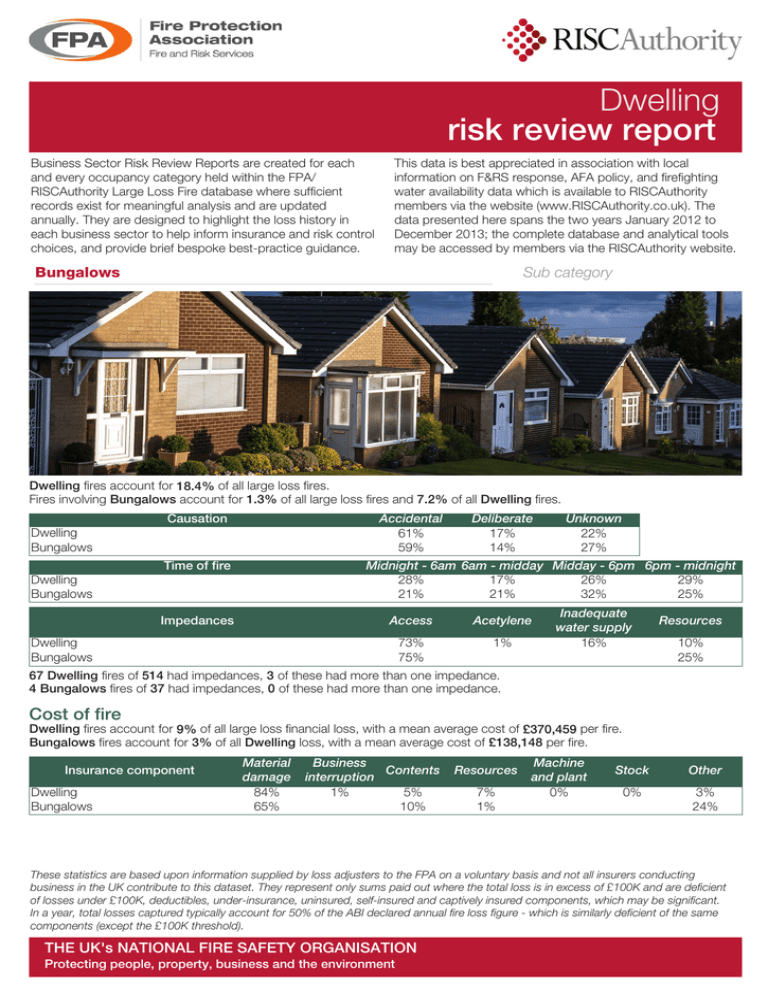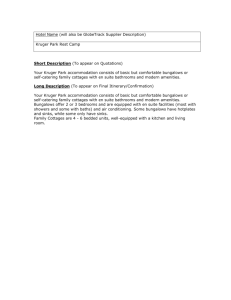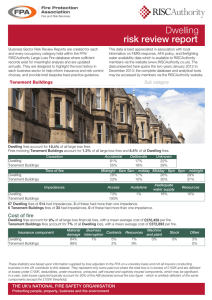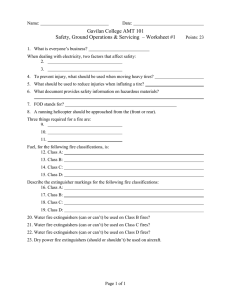risk review report Dwelling
advertisement

Dwelling risk review report Business Sector Risk Review Reports are created for each and every occupancy category held within the FPA/ RISCAuthority Large Loss Fire database where sufficient records exist for meaningful analysis and are updated annually. They are designed to highlight the loss history in each business sector to help inform insurance and risk control choices, and provide brief bespoke best-practice guidance. This data is best appreciated in association with local information on F&RS response, AFA policy, and firefighting water availability data which is available to RISCAuthority members via the website (www.RISCAuthority.co.uk). The data presented here spans the two years January 2012 to December 2013; the complete database and analytical tools may be accessed by members via the RISCAuthority website. Bungalows Sub category Dwelling fires account for 18.4% of all large loss fires. Fires involving Bungalows account for 1.3% of all large loss fires and 7.2% of all Dwelling fires. Accidental 61% 59% Causation Dwelling Bungalows Dwelling Bungalows Time of fire Deliberate 17% 14% Unknown 22% 27% Midnight - 6am 6am - midday Midday - 6pm 6pm - midnight 17% 26% 29% 28% 21% 21% 32% 25% Impedances Access Acetylene 73% 75% 1% Dwelling Bungalows Inadequate water supply 16% Resources 10% 25% 67 Dwelling fires of 514 had impedances, 3 of these had more than one impedance. 4 Bungalows fires of 37 had impedances, 0 of these had more than one impedance. Cost of fire Dwelling fires account for 9% of all large loss financial loss, with a mean average cost of £370,459 per fire. Bungalows fires account for 3% of all Dwelling loss, with a mean average cost of £138,148 per fire. Insurance component Dwelling Bungalows Material damage 84% 65% Business Contents interruption 1% 5% 10% Resources 7% 1% Machine and plant 0% Stock Other 0% 3% 24% These statistics are based upon information supplied by loss adjusters to the FPA on a voluntary basis and not all insurers conducting business in the UK contribute to this dataset. They represent only sums paid out where the total loss is in excess of £100K and are deficient of losses under £100K, deductibles, under-insurance, uninsured, self-insured and captively insured components, which may be significant. In a year, total losses captured typically account for 50% of the ABI declared annual fire loss figure - which is similarly deficient of the same components (except the £100K threshold). THE UK's NATIONAL FIRE SAFETY ORGANISATION Protecting people, property, business and the environment FPA BUSINESS SECTOR RISK REVIEW REPORT FOR DWELLING – BUNGALOWS Fire safety legislation Although bungalows and other single private dwellings are not subject to fire safety legislation, a fire risk assessment should be undertaken when the premises is used as a business, for example as part of a care home or to provide similar services, in compliance with the Regulatory Reform (Fire Safety) Order 2005 (or equivalent legislation in Scotland and Northern Ireland). Fire hazards There are a number of significant fire hazards associated with bungalows; these include: • Accidents while cooking. • Accidents while smoking. • Electrical fire hazards from poorly maintained installations and portable electrical appliances. • Deliberate fire raising. • Unprotected letter slots in front doors. • Residents not testing smoke alarms or removing their batteries. • Excessive combustible materials accumulating as a result of collecting or hoarding. • Rubbish bins, waste materials and old furniture outside in close proximity to the building. • Poorly parked vehicles outside obstructing hydrants and access for firefighters. Risk control recommendations The following risk mitigation measures should be considered to eliminate or reduce the risk of fires in bungalows: • Give careful consideration to the likelihood of deliberate fire raising at the time of the fire risk assessment. Suitable security measures should be implemented that are proportionate to the risk and based on the findings of the fire risk assessment. Suitable measures may include providing locks complying with BS 3621 and installing security lighting. • Review the fire risk assessment periodically, when redecoration or alterations are planned or whenever there are significant changes to the potential sources of ignition, combustible materials present or abilities of the residents (for example restricted mobility or impaired hearing). • Ensure that all escape routes to the outside of the property are kept free from obstructions and combustible materials. • Ensure that doors to rooms are maintained in good condition; they should be shut at night to minimise the spread of smoke onto the escape route and give the occupiers maximum time to escape. • Provide emergency escape lighting that is installed and maintained in accordance with BS 5266 where there is insufficient borrowed light on escape routes. • When designing new bungalows avoid the need to introduce letter slots into fire doors; it is preferable to have a post box outside the building. The latter provides for greater security from fireworks and burning materials being introduced into the home by this route. • Where a letter slot is already provided in the front door, it should be protected by a sheet metal container designed to retain burning materials. (Proprietary boxes are available which have a built-in fire extinguisher.) • Avoid hot work wherever possible, including the use of hot air guns for the stripping of paintwork during redecoration. When hot work cannot be avoided, engage competent contractors and specify that work is controlled by use of a hot work permit system in accordance with RISCAuthority Recommendation RC7. • Ensure that electrical installations are designed, installed and periodically tested by a competent electrician in accordance with the current edition of BS 7671 (the IET Wiring Regulations). Inspections should be carried out on a fire risk assessed basis as recommended in the Periodic Inspection Report. • Portable electrical equipment (such as vacuum cleaners) that is used by cleaners and other staff should be inspected and tested at least in accordance with HSG 107 and/or the IET Code of practice for in-service inspection and testing of electrical equipment. The period between tests should be determined by the fire risk assessment. • Ensure that electrical and gas installations (such as meters and electrical consumer units) are separated from the escape route by a form of construction that provides at least 30 minutes’ fire resistance. • Minimise the spread of fire by effective fire compartmentation within the building, even though it is of only a single storey. Maintain the compartmentation by ensuring that contractors provide suitable fire stopping, in accordance with the FPA Design guide, around pipes and services that are introduced through fire compartment walls, floors and ceilings. Maintain the effectiveness of cavity barriers in ceilings and roof voids. • Provide written information for the residents indicating what they should do in the event of fire. They should also be told in a short leaflet how they should call the fire and rescue service if there are times when staff are not present. Residents should be made aware of heat or smoke detectors that are provided and how they should be tested and maintained. • Residents need to be warned with the minimum of delay of a fire in the premises, especially if they have reduced mobility; a suitable automatic fire detection and alarm system should therefore be installed. The system should have third party certification by a UKAS accredited certification body and be to a recognised category of installation in accordance with BS 5839-6. • Give serious consideration at the design stage to the installation of an automatic fire suppression system into a new property. Sprinkler systems for residential premises should be installed and maintained in compliance with BS 9251 by an engineer with third party certification by a UKAS accredited third party certification body. • Staff should have access to a suitable number of appropriate fire extinguishers in areas such as the kitchen and utility room. Extinguishers should be approved and certificated by an independent, third party certification body, installed in accordance with BS 5306-8 and inspected and maintained in compliance with BS 5306-3. Staff should be trained in their use. • Minimise the storage of combustible waste materials (including unwanted furniture and recycling containers) within 10m of the premises. Where appropriate, provide bollards or kerbs to prevent wheeled bins being located beneath windows. • Liaise with the fire and rescue service where car parking in the neighbourhood may prevent speedy access by firefighting appliances. • Have an effective emergency plan in place to ensure the resilience of the premises and welfare of the residents in the event of a fire. One way of approaching this is to complete the ROBUST business continuity and incident management planning software available free from https://robust.riscauthority.co.uk/ Further information 1. Regulatory Reform (Fire Safety) Order 2005, SI 2005 No 1541, TSO. 2. The Fire (Scotland) Act 2005, asp 5, TSO. 3.Fire Safety (Scotland) Regulations 2006, Scottish SI 2006 No 456, TSO. 4.Fire and Rescue Services (Northern Ireland) Order 2006, SI 2006 No 1254 (NI9), TSO. 5.Fire Safety Regulations (Northern Ireland) 2010, SI 2010 No 325 (NI), TSO. 6.BS 3621: 2007 + A2: 2012, Thief resistant lock assembly. Key egress, BSI. 7.BS 5266-1:2011: Emergency lighting. Code of practice for the emergency escape lighting of premises, BSI. 8.BS 5306-3: 2009: Fire extinguishing installations and equipment on premises. Commissioning and maintenance of portable fire extinguishers. Code of practice, BSI. 9. BS 5306-8: 2012: Fire extinguishing installations and equipment on premises. Selection and positioning of portable fire extinguishers. Code of practice, BSI. 10. BS 5839-6: 2013: Fire detection and fire alarm systems for buildings. Code of practice for the design, installation, commissioning and maintenance of fire detection and fire alarm systems in domestic premises, BSI. 11.BS 7671: 2008 +A1: 2011 + A2: 2013: Requirements for electrical installations (IET Wiring Regulations), BSI. 12.BS 9251: Sprinkler systems for residential and domestic occupancies. Code of practice. BSI. Case history 1.A woman has died in a fire at her sheltered accommodation. Firefighters were called to the blaze in the living room of the bungalow just before 18:45 on Tuesday. The woman, believed to be in her late 80s, was found by fire crews but they were unable to save her. A spokesman for the fire and rescue service said an investigation was under way with the police to establish the cause of the fire. The incident was the second fatality in a fire in the county in seven days; less than a week earlier a woman died when a fire broke out in the living room of her home. 13.RC7: Recommendations for hot work, 2012, FPA. 14.Business resilience: A guide to protecting your business and its people, 2005, FPA. 15.ROBUST software (Resilient Business Software Toolkit): https://robust.riscauthority.co.uk 16.FPA Design guide: The protection of buildings: Core document: Protection of openings and service penetrations from fire, 2005, FPA. 17.HSG 107: Maintaining portable and transportable electrical equipment, 2013, HSE. 18.Code of practice for in-service inspection and testing of electrical equipment, 2012, Institution of Engineering and Technology (IET). 19.Fire safety risk assessment: Sleeping accommodation, 2006, DCLG. 20.Housing – Fire safety: Guidance on fire safety provisions for certain types of existing housing, LACoRS (Local Government Association).


